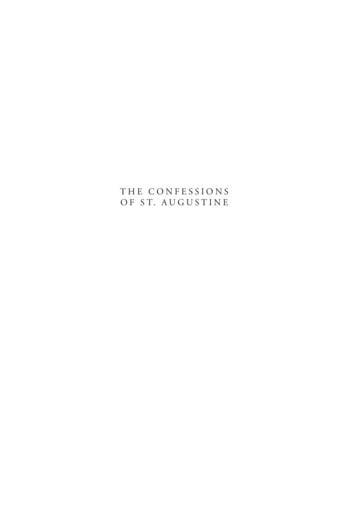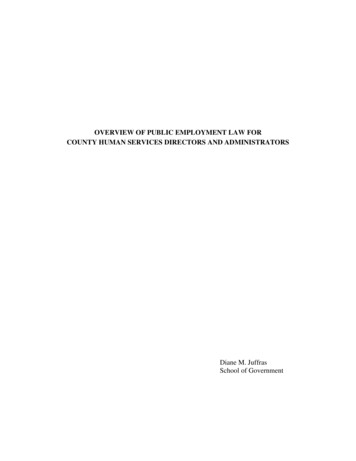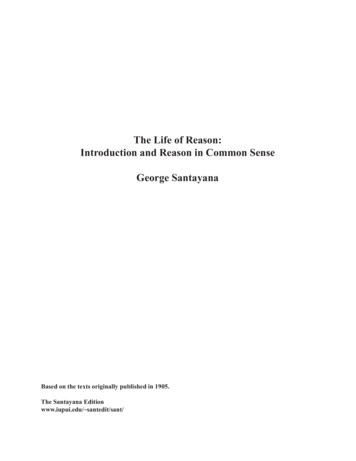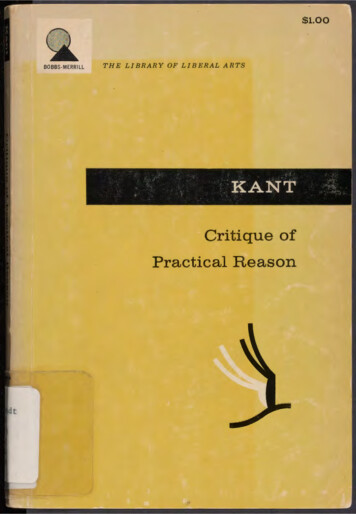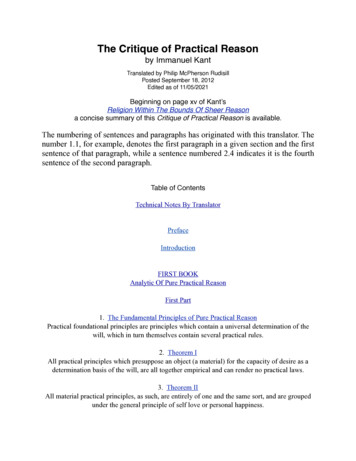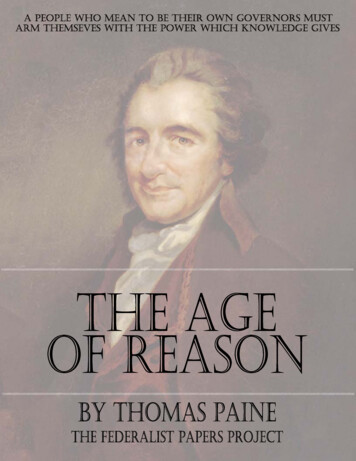
Transcription
THE AGE OF REASONBy Thomas PaineThe Federalist Papers Projectwww.thefederalistpapers.org
The Age of Reason by Thomas PaineTABLE OF CONTENTSAGE OF REASON - PART FIRST . 4Age of Reason, Section 1 . 4Age of Reason, Part First, Section 2 . 6Age of Reason, Part First, Section 3 . 8Age of Reason, Part First, Section 4 . 10Age of Reason, Part First, Section 5 . 13Age of Reason, Part First, Section 6 . 16Age of Reason, Part First, Section 7 . 18Age of Reason, Part First, Section 8 . 20Age of Reason, Part First, Section 9 . 23Age of Reason, Part First, Section 10 . 25Age of Reason, Part First, Section 11 . 28Age of Reason, Part First, Section 12 . 31Age of Reason, Part First, Section 13 . 33Age of Reason, Part First, Section 14 . 36Age of Reason, Part First, Section 15 . 39Thus far I had written on the 28th . 42PREFACE TO PART II. . 44AGE OF REASON. - PART SECOND. . 47Age of Reason, Part II, Section 1 . 47Age of Reason, Part II, Section 2 . 49Age of Reason, Part II, Section 3 . 49Age of Reason, Part II, Section 4 . 52Age of Reason, Part II, Section 5 . 55Age of Reason, Part II, Section 6 . 58Age of Reason, Part II, Section 7 . 63Age of Reason, Part II, Section 8 . 66www.thefederalistpapers.orgPage 2
The Age of Reason by Thomas PaineAge of Reason, Part II, Section 9 . 69Age of Reason, Part II, Section 10 . 72Age of Reason, Part II, Section 11 . 75Age of Reason, Part II, Section 12 . 78Age of Reason, Part II, Section 13 . 81Age of Reason, Part II, Section 14 . 85Age of Reason, Part II, Section 15 . 88Age of Reason, Part II, Section 16 . 92Age of Reason, Part II, Section 17 . 96Age of Reason, Part II, Section 18 . 98Age of Reason, Part II, Section 19 . 101Age of Reason, Part II, Section 20 . 103Age of Reason, Part II, Section 21 . 106END OF THE SECOND PART. . 110AGE OF REASON, PART THIRD . 111Age of Reason, Part III, Section 1 . 111Age of Reason, Part III, Section 2 - THE BOOK OF MARK. . 130Age of Reason, Part III, Section 3 - THE BOOK OF JOHN. . 133Age of Reason, Part III, Section 4 . 136Age of Reason, Part III, Section 5 . 146Age of Reason, Part III, Section 6 - My Private Thoughts on a Future State. . 147Age of Reason Footnotes . 148www.thefederalistpapers.orgPage 3
The Age of Reason by Thomas PaineAGE OF REASON - PART FIRSTAge of Reason, Section 1IT has been my intention, for several years past, to publish my thoughts upon religion. I am wellaware of the difficulties that attend the subject, and from that consideration, had reserved it to amore advanced period of life. I intended it to be the last offering I should make to my fellowcitizens of all nations, and that at a time when the purity of the motive that induced me to it,could not admit of a question, even by those who might disapprove the work.The circumstance that has now taken place in France of the total abolition of the whole nationalorder of priesthood, and of everything appertaining to compulsive systems of religion, andcompulsive articles of faith, has not only precipitated my intention, but rendered a work of thiskind exceedingly necessary, lest in the general wreck of superstition, of false systems ofgovernment, and false theology, we lose sight of morality, of humanity, and of the theology thatis true.As several of my colleagues and others of my fellow-citizens of France have given me theexample of making their voluntary and individual profession of faith, I also will make mine; andI do this with all that sincerity and frankness with which the mind of man communicates withitself.I believe in one God, and no more; and I hope for happiness beyond this life.I believe in the equality of man; and I believe that religious duties consist in doing justice, lovingmercy, and endeavoring to make our fellow-creatures happy.But, lest it should be supposed that I believe in many other things in addition to these, I shall, inthe progress of this work, declare the things I do not believe, and my reasons for not believingthem.I do not believe in the creed professed by the Jewish church, by the Roman church, by the Greekchurch, by the Turkish church, by the Protestant church, nor by any church that I know of. Myown mind is my own church.All national institutions of churches, whether Jewish, Christian or Turkish, appear to me no otherthan human inventions, set up to terrify and enslave mankind, and monopolize power and profit.I do not mean by this declaration to condemn those who believe otherwise; they have the sameright to their belief as I have to mine. But it is necessary to the happiness of man, that he bewww.thefederalistpapers.orgPage 4
The Age of Reason by Thomas Painementally faithful to himself. Infidelity does not consist in believing, or in disbelieving; it consistsin professing to believe what he does not believe.It is impossible to calculate the moral mischief, if I may so express it, that mental lying hasproduced in society. When a man has so far corrupted and prostituted the chastity of his mind, asto subscribe his professional belief to things he does not believe, he has prepared himself for thecommission of every other crime. He takes up the trade of a priest for the sake of gain, and inorder to qualify himself for that trade, he begins with a perjury. Can we conceive any thing moredestructive to morality than this?Soon after I had published the pamphlet Common Sense, in America, I saw the exceedingprobability that a revolution in the system of government would be followed by a revolution inthe system of religion. The adulterous connection of church and state, wherever it had takenplace, whether Jewish, Christian, or Turkish, had so effectually prohibited by pains and penalties,every discussion upon established creeds, and upon first principles of religion, that until thesystem of government should be changed, those subjects could not be brought fairly and openlybefore the world; but that whenever this should be done, a revolution in the system of religionwould follow. Human inventions and priestcraft would be detected; and man would return to thepure, unmixed and unadulterated belief of one God, and no more.Every national church or religion has established itself by pretending some special mission fromGod, communicated to certain individuals. The Jews have their Moses; the Christians their JesusChrist, their apostles and saints; and the Turks their Mahomet, as if the way to God was not opento every man alike.Each of those churches show certain books, which they call revelation, or the word of God. TheJews say, that their word of God was given by God to Moses, face to face; the Christians say,that their word of God came by divine inspiration: and the Turks say, that their word of God (theKoran) was brought by an angel from Heaven. Each of those churches accuse the other ofunbelief; and for my own part, I disbelieve them all.As it is necessary to affix right ideas to words, I will, before I proceed further into the subject,offer some other observations on the word revelation. Revelation, when applied to religion,means something communicated immediately from God to man.No one will deny or dispute the power of the Almighty to make such a communication, if hepleases. But admitting, for the sake of a case, that something has been revealed to a certainperson, and not revealed to any other person, it is revelation to that person only. When he tells itto a second person, a second to a third, a third to a fourth, and so on, it ceases to be a revelationto all those persons. It is revelation to the first person only, and hearsay to every other, andconsequently they are not obliged to believe it.www.thefederalistpapers.orgPage 5
The Age of Reason by Thomas PaineIt is a contradiction in terms and ideas, to call anything a revelation that comes to us at secondhand, either verbally or in writing. Revelation is necessarily limited to the first communication— after this, it is only an account of something which that person says was a revelation made tohim; and though he may find himself obliged to believe it, it cannot be incumbent on me tobelieve it in the same manner; for it was not a revelation made to me, and I have only his wordfor it that it was made to him.When Moses told the children of Israel that he received the two tables of the commandmentsfrom the hands of God, they were not obliged to believe him, because they had no other authorityfor it than his telling them so; and I have no other authority for it than some historian telling meso. The commandments carry no internal evidence of divinity with them; they contain some goodmoral precepts, such as any man qualified to be a lawgiver, or a legislator, could producehimself, without having recourse to supernatural intervention.[FOOTNOTE 1]Age of Reason, Part First, Section 2When I am told that the Koran was written in Heaven and brought to Mahomet by an angel, theaccount comes too near the same kind of hearsay evidence and second-hand authority as theformer. I did not see the angel myself, and, therefore, I have a right not to believe it.When also I am told that a woman called the Virgin Mary, said, or gave out, that she was withchild without any cohabitation with a man, and that her betrothed husband, Joseph, said that anangel told him so, I have a right to believe them or not; such a circumstance required a muchstronger evidence than their bare word for it; but we have not even this — for neither Joseph norMary wrote any such matter themselves; it is only reported by others that they said so — it ishearsay upon hearsay, and I do not choose to rest my belief upon such evidence.It is, however, not difficult to account for the credit that was given to the story of Jesus Christbeing the son of God. He was born when the heathen mythology had still some fashion andrepute in the world, and that mythology had prepared the people for the belief of such a story.Almost all the extraordinary men that lived under the heathen mythology were reputed to be thesons of some of their gods. It was not a new thing, at that time, to believe a man to have beencelestially begotten; the intercourse of gods with women was then a matter of familiar opinion.Their Jupiter, according to their accounts, had cohabited with hundreds: the story, therefore, hadnothing in it either new, wonderful, or obscene; it was conformable to the opinions that thenprevailed among the people called Gentiles, or Mythologists, and it was those people only thatbelieved it. The Jews who had kept strictly to the belief of one God, and no more, and who hadalways rejected the heathen mythology, never credited the story.It is curious to observe how the theory of what is called the Christian church sprung out of thetail of the heathen mythology. A direct incorporation took place in the first instance, by makingthe reputed founder to be celestially begotten. The trinity of gods that then followed was no otherthan a reduction of the former plurality, which was about twenty or thirty thousand: the statue ofwww.thefederalistpapers.orgPage 6
The Age of Reason by Thomas PaineMary succeeded the statue of Diana of Ephesus; the deification of heroes changed into thecanonization of saints; the Mythologists had gods for everything; the Christian Mythologists hadsaints for everything; the church became as crowded with one, as the Pantheon had been with theother, and Rome was the place of both. The Christian theory is little else than the idolatry of theancient Mythologists, accommodated to the purposes of power and revenue; and it yet remains toreason and philosophy to abolish the amphibious fraud.Nothing that is here said can apply, even with the most distant disrespect, to the real character ofJesus Christ. He was a virtuous and an amiable man. The morality that he preached and practisedwas of the most benevolent kind; and though similar systems of morality had been preached byConfucius, and by some of the Greek philosophers, many years before; by the Quakers since;and by many good men in all ages, it has not been exceeded by any.Jesus Christ wrote no account of himself, of his birth, parentage, or any thing else; not a line ofwhat is called the New Testament is of his own writing. The history of him is altogether the workof other people; and as to the account given of his resurrection and ascension, it was thenecessary counterpart to the story of his birth. His historians having brought him into the worldin a supernatural manner, were obliged to take him out again in the same manner, or the first partof the story must have fallen to the ground.The wretched contrivance with which this latter part is told exceeds every thing that went beforeit. The first part, that of the miraculous conception, was not a thing that admitted of publicity;and therefore the tellers of this part of the story had this advantage, that though they might not becredited, they could not be detected. They could not be expected to prove it, because it was notone of those things that admitted of proof, and it was impossible that the person of whom it wastold could prove it himself.But the resurrection of a dead person from the grave, and his ascension through the air, is a thingvery different as to the evidence it admits of, to the invisible conception of a child in the womb.The resurrection and ascension, supposing them to have taken place, admitted of public andocular demonstration, like that of the ascension of a balloon, or the sun at noon-day, to allJerusalem at least. A thing which everybody is required to believe, requires that the proof andevidence of it should be equal to all, and universal; and as the public visibility of this last relatedact was the only evidence that could give sanction to the former part, the whole of it falls to theground, because that evidence never was given. Instead of this, a small number of persons, notmore than eight or nine, are introduced as proxies for the whole world, to say they saw it, and allthe rest of the world are called upon to believe it. But it appears that Thomas did not believe theresurrection, and, as they say, would not believe without having ocular and manualdemonstration himself. So neither will I, and the reason is equally as good for me, and for everyother person, as for Thomas.It is in vain to attempt to palliate or disguise this matter. The story, so far as relates to thesupernatural part, has every mark of fraud and imposition stamped upon the face of it. Who werewww.thefederalistpapers.orgPage 7
The Age of Reason by Thomas Painethe authors of it is as impossible for us now to know, as it is for us to be assured that the books inwhich the account is related were written by the persons whose names they bear; the bestsurviving evidence we now have respecting that affair is the Jews. They are regularly descendedfrom the people who lived in the times this resurrection and ascension is said to have happened,and they say, it is not true. It has long appeared to me a strange inconsistency to cite the Jews asa proof of the truth of the story. It is just the same as if a man were to say, I will prove the truthof what I have told you by producing the people who say it is false.That such a person as Jesus Christ existed, and that he was crucified, which was the mode ofexecution at that day, are historical relations strictly within the limits of probability. He preachedmost excellent morality and the equality of man; but he preached also against the corruptions andavarice of the Jewish priests, and this brought upon him the hatred and vengeance of the wholeorder of priesthood. The accusation which those priests brought against him was that of seditionand conspiracy against the Roman government, to which the Jews were then subject andtributary; and it is not improbable that the Roman government might have some secretapprehensions of the effects of his doctrine, as well as the Jewish priests; neither is it improbablethat Jesus Christ had in contemplation the delivery of the Jewish nation from the bondage of theRomans. Between the two, however, this virtuous reformer and revolutionist lost his life.It is upon this plain narrative of facts, together with another case I am going to mention, that theChristian Mythologists, calling themselves the Christian Church, have erected their fable, which,for absurdity and extravagance, is not exceeded by anything that is to be found in the mythologyof the ancients.Age of Reason, Part First, Section 3The ancient Mythologists tell us that the race of Giants made war against Jupiter, and that one ofthem threw a hundred rocks against him at one throw; that Jupiter defeated him with thunder,and confined him afterward under Mount Etna, and that every time the Giant turns himselfMount Etna belches fire.It is here easy to see that the circumstance of the mountain, that of its being a volcano, suggestedthe idea of the fable; and that the fable is made to fit and wind itself up with that circumstance.The Christian Mythologists tell us that their Satan made war against the Almighty, who defeatedhim, and confined him afterward, not under a mountain, but in a pit. It is here easy to see that thefirst fable suggested the idea of the second; for the fable of Jupiter and the Giants was told manyhundred years before that of Satan.Thus far the ancient and the Christian Mythologists differ very little from each other. But thelatter have contrived to carry the matter much farther. They have contrived to connect thefabulous part of the story of Jesus Christ with the fable originating from Mount Etna; and inorder to make all the parts of the story tie together, they have taken to their aid the traditions ofwww.thefederalistpapers.orgPage 8
The Age of Reason by Thomas Painethe Jews; for the Christian mythology is made up partly from the ancient mythology and partlyfrom the Jewish traditions.The Christian Mythologists, after having confined Satan in a pit, were obliged to let him outagain to bring on the sequel of the fable. He is then introduced into the Garden of Eden, in theshape of a snake or a serpent, and in that shape he enters into familiar conversation with Eve,who is no way surprised to hear a snake talk; and the issue of this tete-a-tete is that he persuadesher to eat an apple, and the eating of that apple damns all mankind.After giving Satan this triumph over the whole creation, one would have supposed that theChurch Mythologists would have been kind enough to send him back again to the pit; or, if theyhad not done this, that they would have put a mountain upon him (for they say that their faith canremove a mountain), or have put him under a mountain, as the former mythologists had done, toprevent his getting again among the women and doing more mischief. But instead of this theyleave him at large, without even obliging him to give his parole- the secret of which is, that theycould not do without him; and after being at the trouble of making him, they bribed him to stay.They promised him ALL the Jews, ALL the Turks by anticipation, nine-tenths of the worldbeside, and Mahomet into the bargain. After this, who can doubt the bountifulness of theChristian Mythology?Having thus made an insurrection and a battle in Heaven, in which none of the combatants couldbe either killed or wounded — put Satan into the pit — let him out again — giving him atriumph over the whole creation — damned all mankind by the eating of an apple, theseChristian Mythologists bring the two ends of their fable together. They represent this virtuousand amiable man, Jesus Christ, to be at once both God and Man, and also the Son of God,celestially begotten, on purpose to be sacrificed, because they say that Eve in her longing hadeaten an apple.Putting aside everything that might excite laughter by its absurdity, or detestation by itsprofaneness, and confining ourselves merely to an examination of the parts, it is impossible toconceive a story more derogatory to the Almighty, more inconsistent with his wisdom, morecontradictory to his power, than this story is.In order to make for it a foundation to rise upon, the inventors were under the necessity of givingto the being whom they call Satan, a power equally as great, if not greater than they attribute tothe Almighty. They have not only given him the power of liberating himself from the pit, afterwhat they call his fall, but they have made that power increase afterward to infinity. Before thisfall they represent him only as an angel of limited existence, as they represent the rest. After hisfall, he becomes, by their account, omnipresent. He exists everywhere, and at the same time. Heoccupies the whole immensity of space.Not content with this deification of Satan, they represent him as defeating, by stratagem, in theshape of an animal of the creation, all the power and wisdom of the Almighty. They representwww.thefederalistpapers.orgPage 9
The Age of Reason by Thomas Painehim as having compelled the Almighty to the direct necessity either of surrendering the whole ofthe creation to the government and sovereignty of this Satan, or of capitulating for its redemptionby coming down upon earth, and exhibiting himself upon a cross in the shape of a man.Had the inventors of this story told it the contrary way, that is, had they represented the Almightyas compelling Satan to exhibit himself on a cross, in the shape of a snake, as a punishment for hisnew transgression, the story would have been less absurd — less contradictory. But instead ofthis, they make the transgressor triumph, and the Almighty fall.That many good men have believed this strange fable, and lived very good lives under that belief(for credulity is not a crime), is what I have no doubt of. In the first place, they were educated tobelieve it, and they would have believed anything else in the same manner. There are also manywho have been so enthusiastically enraptured by what they conceived to be the infinite love ofGod to man, in making a sacrifice of himself, that the vehemence of the idea has forbidden anddeterred them from examining into the absurdity and profaneness of the story. The moreunnatural anything is, the more it is capable of becoming the object of dismal admiration.But if objects for gratitude and admiration are our desire, do they not present themselves everyhour to our eyes? Do we not see a fair creation prepared to receive us the instant we are born —a world furnished to our hands, that cost us nothing? Is it we that light up the sun, that pour downthe rain, and fill the earth with abundance? Whether we sleep or wake, the vast machinery of theuniverse still goes on. Are these things, and the blessings they indicate in future, nothing to us?Can our gross feelings be excited by no other subjects than tragedy and suicide? Or is thegloomy pride of man become so intolerable, that nothing can flatter it but a sacrifice of theCreator?I know that this bold investigation will alarm many, but it would be paying too great acompliment to their credulity to forbear it on their account; the times and the subject demand itto be done. The suspicion that the theory of what is called the Christian Church is fabulous isbecoming very extensive in all countries; and it will be a consolation to men staggering underthat suspicion, and doubting what to believe and what to disbelieve, to see the object freelyinvestigated. I therefore pass on to an examination of the books called the Old and NewTestament.Age of Reason, Part First, Section 4These books, beginning with Genesis and ending with Revelation (which, by the by, is a book ofriddles that requires a revelation to explain it), are, we are told, the word of God. It is, therefore,proper for us to know who told us so, that we may know what credit to give to the report. Theanswer to this question is, that nobody can tell, except that we tell one another so. The case,however, historically appears to be as follows:www.thefederalistpapers.orgPage 10
The Age of Reason by Thomas PaineWhen the Church Mythologists established their system, they collected all the writings theycould find, and managed them as they pleased. It is a matter altogether of uncertainty to uswhether such of the writings as now appear under the name of the Old and New Testament are inthe same state in which those collectors say they found them, or whether they added, altered,abridged, or dressed them up.Be this as it may, they decided by vote which of the books out of the collection they had madeshould be the WORD OF GOD, and which should not. They rejected several; they voted othersto be doubtful, such as the books called the Apocrypha; and those books which had a majority ofvotes, were voted to be the word of God. Had they voted otherwise, all the people, since callingthemselves Christians, had believed otherwise — for the belief of the one comes from the vote ofthe other. Who the people were that did all this, we know nothing of; they called themselves bythe general name of the Church, and this is all we know of the matter.As we have no other external evidence or authority for believing these books to be the word ofGod than what I have mentioned, which is no evidence or authority at all, I come, in the nextplace, to examine the internal evidence contained in the books themselves.In the former part of this Essay, I have spoken of revelation; I now proceed further with thatsubject, for the purpose of applying it to the books in question.Revelation is a communication of something which the person to whom that thing is revealed didnot know before. For if I have done a thing, or seen it done, it needs no revelation to tell me Ihave done it, or seen it, nor to enable me to tell it, or
I believe in one God, and no more; and I hope for happiness beyond this life. I believe in the equality of man; and I believe that religious duties consist in doing justice, loving mercy, and endeavoring to make our fellow-creatures happy. But, lest it should be supposed that I belie



